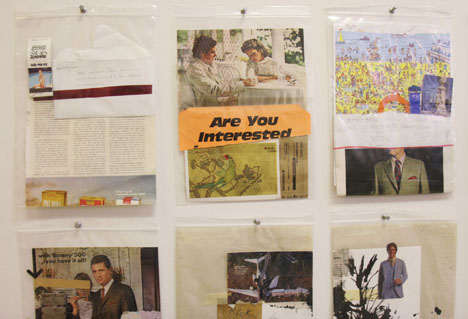‘Conversations About Something’ exhibit show cases Ducett’s artwork
November 7, 2006
University alumnus Andy Ducett just graduated from the school of Art and Design last spring, but he is no novice to having his work on display. He said he has had several exhibitions over the last five years.
On Oct. 31, the Illinois Program for Research in the Humanities opened an exhibit of his work called “Conversations About Something.”
The exhibit features 350 mixed media collages compiled in 9″x12″ Ziploc bags. It will be open through Dec. 8.
“The collages are indicative of an ongoing work since 2001,” Ducett said.
He described himself as a habitual collector, calling it the main motivation for the work. The collages contain everyday things such as pictures, plane tickets, notes and letters.
Get The Daily Illini in your inbox!
“Certain things catch my eye – not necessarily artistic things,” Ducett said.
The collages hang on the walls of the program’s building, which is located at 805 W. Pennsylvania Ave. Some of the collages seem easier to read than others.
For example, one features a man’s head, cut off by the words “rush! rush! rush!” referring to where the brain should be. Above this is a picture of a woman.
Another contains a Polaroid of the game Stratego, a series of letters, a note written in German, and a series of backward numbers.
Ducett said the collages are open to interpretation and that different people will take different meanings from them.
He said he likes to see “what kind of things happen when disparate objects are paired.”
Odd juxtapositions create different narrative possibilities, he added.
He said he usually starts with a catalyst object and relates other objects to it in a variety of subjective ways.
Professor Matti Bunzl, director of the program, said the building usually hosts two shows a semester.
“Usually we approach artists and we turn our walls over to them,” Bunzl said.
He described Ducett as a talented artist and added that he had seen Ducett’s work around town.
The decision to host the exhibit was a mutual discussion between Ducett and the program, rather than one party approaching the other.
Bunzl said that some of the exhibits draw a lot of students.
“Everything we do is open to the public,” he said.
Angela Pfammatter, sophomore in Communications and president of the Art Club, stressed the importance of having work on display.
“Galleries and exhibits are the best way to be seen,” she said. “The only other way you really get heard is word of mouth.”
Ducett said exhibition of artwork allows the artist and observer to switch roles.
“I really like watching people looking at stuff … and exploring the work that I make,” he said.
Ducett is currently employed at the Walker Art Center in Minnesota. He said he could be teaching at a university in the near future.







